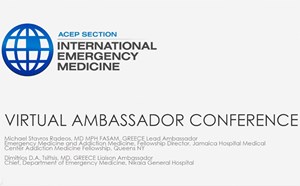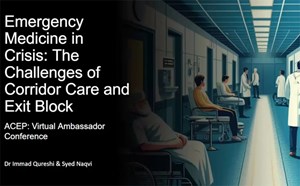Ukraine War and Mass Migration
Watch this International EM Section Virtual Ambassador Conference webinar covering emergency medicine in Ukraine. Dr. Diana Cimpoesu and Dr. Brian McMurray present.
Read the Full Transcript
- Next up, we have two speakers talking about the current conflict in Ukraine, and the first will be the representative from Romania.
- Thank you very much for the opportunity and the invitation. My name is Diana Cimpoesu. I'm professor in emergency medicine in Iasi, University of Medicine and Pharmacy, near the border with Ukraine and the Republic of Moldova. And the presentation will be about our work during the last two years because we are so close with Ukraine and the Republic of Moldova. Republic of Moldova, it's also a former part of Russian Federation, and they have a lot of Romanian population. So our work start two years ago, 24 of February. Yesterday was not a celebration, it was a day when we remember that we start two years ago. The next slide. When the refugees from Ukraine, especially from the south part of Ukraine, start to cross the border with usually a lot of ladies, with very small child, with only a few things, and a lot of fear, a lot of diseases, a lot of problems. They cross the border, and we start our work on the border point. Next slide, please. Our emergency medical service work together with firefighter. And we organize different board intervention point on the northeast part of Romania. It's a part where I'm responsible for emergency medical service, the coordination also for emergency department, but also for prehospital EMS, together with firefighter that in our country is called SMURD. It's mobile intervention, medical and paramedical. So we organize the border point, and we start to treat many patients. The next slide, please. Romania was maybe the second country as number where the refugees from Ukraine went, but not many of them remain. It was about 3 million Ukrainian people, but now we have only 80,000 Ukrainian citizen remaining and that live in Romania. The next slide, please. We did something new that we never did in our professional life. We were with our team in different border point, and this is Suceava border point where we work for the health of Ukrainian refugees. The next slide. Also, this point with the Republic of Moldova. Because many of the Ukrainian refugees cross the Republic of Moldova, they stay maybe a few hours or on one, two days so far. And after they cross the border to Romania and they come in Romania. Next slide. We organize the refugees camp. And we collect here not only medical service, but also water, food, drugs, what they need. And it was in collaboration with some other country and with different European and international organizations. But the work was done specially by our team. Next slide, please. Something also new was the transfer, the patient transfer from the border with Ukraine and from Republic of Moldova. The majority of these patients were oncologic patients or newborns with congenital cardiac malformation. And we pick with our ambulance, a red ambulance, from Chisinau. It's a picture here. And we cross the border in Romania because Romania, it's a European Union country and a NATO country, and it's safe to live in Romania. They are looking for safety. And we bring them to our hospital or to different other hospital in the European Union. Next slide. This is a border with Republic of Moldova. Some ambulance come with the refugees, with a patient on the border, and we transfer from an ambulance to another, or we cross with our ambulance, the Republic of Moldova. Usually, we fly for HEMS mission for Republic of Moldova, but in 2022 that was impossible because all the flights were canceled. Next slide. The next slide. And they flew to different center in Europe. Next slide. And some of them, we keep them in the Romanian hospital. Next slide, please. It is something new. We transfer to Italy, Belgium, Germany. And also, we had this flight from the border with Ukraine for newborns. For newborns with different pathology, but also for healthy newborns, as this little baby born in Ukraine from a surrogate mother because the legislation allowed this. And we carry this little girl to Romania to find the parents in Romania, in one country, in Romania. Next one. Next slide, please. And we have some gunshot injuries. This family come without any announcement in our department. Usually, we treat different normal pathology, but sometimes we have war injury that is new, and we keep them in our hospital or we transfer to different other European country. Next one. What was also new was the hubs that we design in the north part of our region, and we collect many aids from different European country and not only, and we transfer according to the need into Ukraine. It was ambulance, but also food, water, a lot of medical material, what they need, and what different European country transfer in Romania for this hub to be transferred in Ukraine. So the next one. The next slide, it's the last one. The problems decrease now. What is growing in Romania, it's the fear that the war will continue and extend. Thank you very much.
- Thank you so much. We have our next representative talking about the Ukrainian crisis. And go ahead.
- Thank you. Well, it's been my joy to go to Ukraine 45 times since 1996, and three times since the war. Somewhat ironic is that Diana and I have never met, because the portal through which I've during the war gone to Ukraine is no longer of course flying into Kyiv, but now is flying into Bucharest, and then on domestic airline into Iasi. Which by the way, it looks like it's spelled... It looks like it should be pronounced Iasi. It's I-A-S-I, but it's pronounced Yosh in the northeast. And that's how I get into Ukraine, either to the north or to the east through Moldova. So I'm looking forward to meeting Diana. And by the way, Mollie, a little warning, I'm gonna be asking you how to help shepherd Diana into full membership and attendance at ACEP24.
- [Mollie] Sounds great.
- I'm preaching to the choir when I tell you that everything that we do collaboratively, and Dr. Galletta is the prototype of this ideal involvement, it's based on relationships. And I had the good fortune of having a relationship starting in about 2008 with Dr. Vitaliy Kryluk, who is the ACEP liaison now for Ukraine, one of the two. And he's director of the Ministry of Health's PreHospital and Disaster Medication Education throughout the nation. Well, you can imagine in wartime that those two topics and areas of influence and leadership are pivotal. So Maidan occurred in 2014, as we all know, when Putin did his initial foray into Ukraine and then annexed Crimea and also functionally annexed much of Donbas to the east. And Vitaliy, I've always asked him, well, who do you want me to bring on the next trip? And he said, "We really need a battlefield surgeon." So I was fortunate here at Vanderbilt, I live in Nashville, to have a colleague, who's a twice decorated army Bronze Star recipient from Afghanistan and Iraq, come to Ukraine and start to promote the use of many things, battlefield strategy, surgery. But also, if you can believe it or not, and I don't know if anybody else represents a country where the Soviet hangover. Can you imagine that even before the war, it was illegal, illegal to give uncrossmatched blood regardless of whether the patient was in hemorrhagic shock. So pre-war, that meant that, you know, anybody with an esophageal variceal bleed, or postpartum hemorrhage, or whatever, you know, might be the cause of hemorrhagic shock. Basically, if they presented in hemorrhagic shock, they were dead. Now because of the war, Vitaliy was able to promote and succeed in getting the minister of health to allow it. Even my daughter, who's a nurse practitioner, gave the first Stop The Bleed lecture there in Cherkasy in 2017. And we can go to the next slide. So in Ukraine, like I said, hemorrhagic shock was a death sentence unless you were very lucky. I mean, 90 minutes minimum to get it fully crossmatched. So a number of things happened, and Vitaliy was able to prevail. And now they also have approved also emergency field whole blood transfusion. And this is something that we civilian doctors would seldom have had any familiarity with, but it's basically the concept of a Walking Blood Bank. It was pioneered by the US Army and the Israeli army, and it's now become more prevalent in other countries as well. So you literally can do a quick in-the-field assessment of somebody's blood type. So all the hospitals now in Ukraine have the Massive Transfusion Protocol of Vanderbilt, basically. And there's now even a firm in Kyiv manufacturing a version of the North American Rescue Whole Blood Field Transfusion kit, to which they made it even better by adding a gram of tranexamic acid and 500 ml of saline. Their army medics now also carry lyophilized plasma, which I think we're gonna see used increasingly in other countries, including our own pre-hospital. It's basically freeze-dried plasma. Next slide. So next slide. I'm just gonna quickly run through this. The main thing I would want to make people aware of, if you're not, is that component therapy, which of course is fractionating into packed red blood cells, plasma and platelets, was driven not by efficacy, clinically, but by ability to have a better shelf life. And what we're finding out now increasingly is even though the Massive Transfusion Protocols are based on component therapy, there's a growing body of evidence that what we should be doing is whole blood especially for traumatic hemorrhagic shock. It'll be interesting to see how that goes. But in the interim, component therapy is not a piece of cake to coordinate. And the only way a Massive Transfusion Protocol works is to have close coordination between the emergency department, the blood bank, and the trauma team. If you don't have that, it ain't gonna happen. And that's still a challenge even in our country in case you've ever been in a setting, but it's getting a lot better. Next slide. And I would wanna mention that the... I'm just gonna flash through this. This is basically the protocol checklist. And you can see that if you have a patient early, you're gonna probably give them TXA. You're automatically gonna give them calcium to prevent hypocalcemia. And in certain centers, settings rather, you might even give them desmopressin. And I don't know if these slides are gonna be available for anybody, but I have tried to keep references, you'll notice, if you want. Next. And next. So these are the three ways, three ways I should say, to assess a patient as to whether they need field whole blood transfusion. So you can see the ABC score. Well, the problem there is how many people in how many countries have a point-of-care ultrasound in the field? Not too many. So then you are left with either the shock index, or my favorite, because I'm old school and low tech by nature, is the gestalt. If you don't have a radial pulse, or a weak one, and you get a carotid pulse of 120 or more, and the patient's showing signs of poor perfusion, you don't need any shock index or ABC score. You know this patient needs blood ASAP. Next slide. So the EldonCard is basically a fingerstick, and in four minutes you know the person's blood type. It's by agglutination, and it's really easy to read. The protocol is, if it's a soldier or a civilian who is confident of their blood type, you only check it once. If they don't know their blood type, but they're willing to be a donor and they think they might be O, then you double check, you do the Eldon twice. And it's of course O negative for any recipient. But some countries don't realize that O positive is fine for any man or a woman over childbearing age. And then if you can't find an O recipient, your last point would be to get type specific. Next. And in terms of resources, there's this amazing organization. I don't know if any of you, Dr. Galletta, if you know about THOR, but THOR is amazing. They are the Trauma Hemostasis and Oxygenation Research Network, Norway based, and this is their site. And these folks are increasingly working in other areas of Ukraine where I haven't been recently, like Odesa. And they have translated into Ukrainian a beautiful module, online module about how to do in-field whole blood transfusion. And they also even have a field transfusion online course that you can take. So THOR is amazing. I would regard them next to the military, which their site is at the bottom. I would say THOR of all the civilian efforts to promote aggressive and appropriate blood transfusion in the field is number one in the world. I think I'm up against my time. I just want to say that working in Ukraine has been obviously a great challenge. If you avoid the areas of battlefront, and I understand Ashley is right now in Lviv, you realize that life goes on. I have an app on my phone called Air Alarm Ukraine, and I was able to know when I needed to get to shelter. But it's not like life stops. People are working, people are still living their lives. It's just that Putin even by war standards is not ethical. And what he's doing is preposterous and unjustified. And I hope my US Congress steps up to the plate instead of dithering. Thanks so much.



